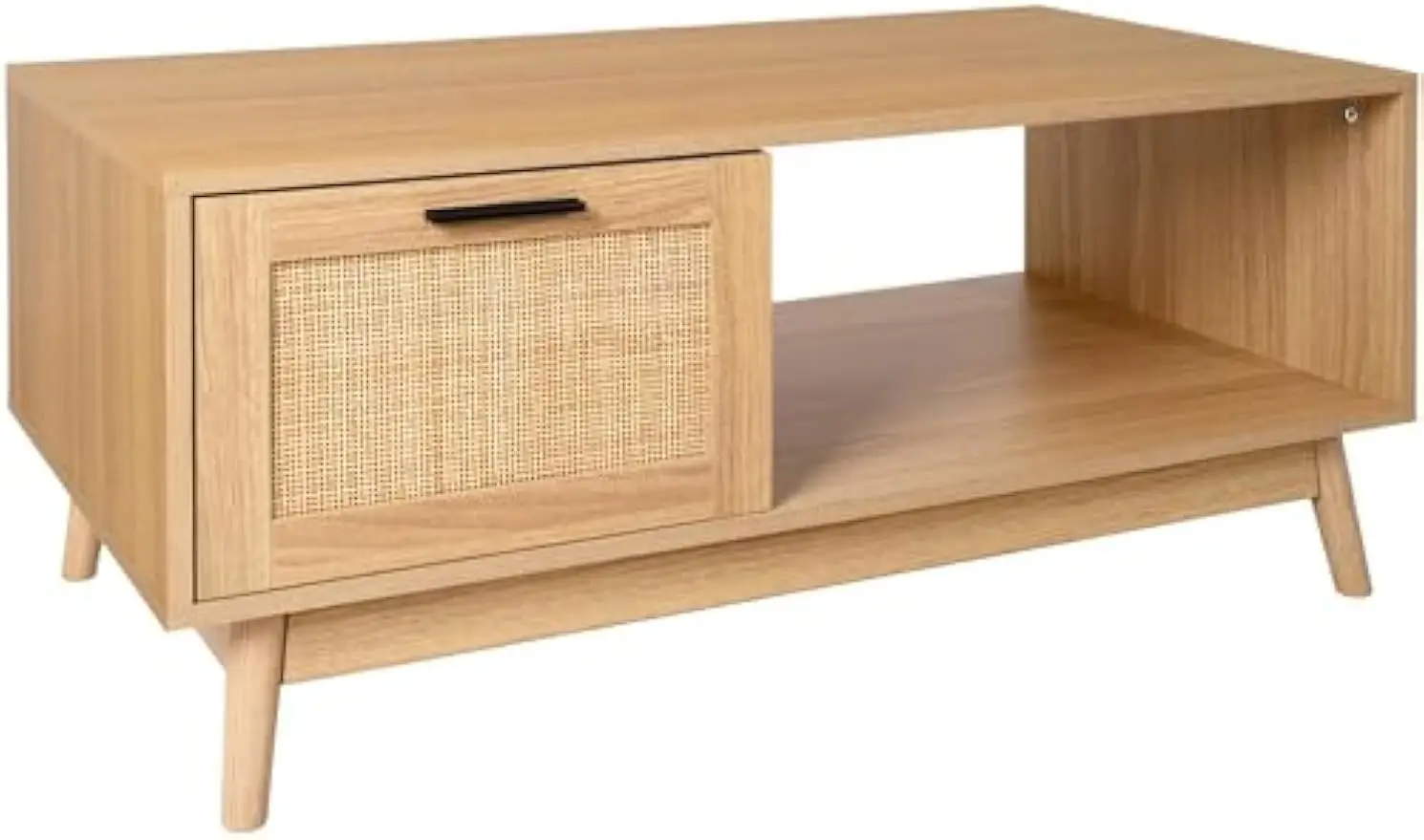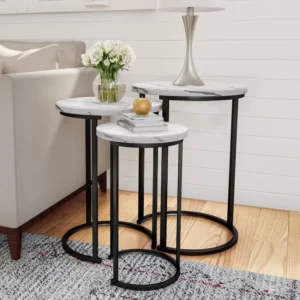Introduction: Why Rectangular Coffee Tables Remain a Design Cornerstone
Few furniture pieces define a living space as distinctly as a rectangular coffee table. These versatile fixtures serve as both functional necessities and design statements, anchoring seating arrangements while providing a stage for everything from morning coffee to evening gatherings.
The enduring popularity of rectangular coffee tables stems from their perfect balance of form and function. Unlike other shapes, rectangular tables offer:
- Maximum usable surface area for books, décor, and refreshments
- Proportional harmony with standard sofa arrangements
- Versatile placement options for various room configurations
- Timeless appeal that transcends passing design trends
Understanding the design features of rectangular coffee tables is essential for creating a cohesive, functional living space. This comprehensive guide will explore all aspects of these versatile pieces—from materials and construction to style and maintenance.
Whether you’re searching for the perfect centerpiece for your living room or hoping to better understand the elements that make mid-century modern rectangular coffee tables so desirable, this guide will equip you with the knowledge to make informed decisions that enhance both the functionality and aesthetics of your space.
The Advantages of Rectangular Coffee Tables
When selecting a coffee table shape, the rectangular option offers numerous practical advantages that explain its enduring popularity in home design.
One of the most significant benefits is the generous surface area rectangular tables provide. This practical advantage means more space for books, beverages, remote controls, and decorative items without creating a cluttered appearance. A standard rectangular coffee table (approximately 48 inches by 24 inches) offers about 8 square feet of usable surface—significantly more than comparably sized round or square alternatives.
Rectangular tables complement standard seating arrangements exceptionally well. The linear shape naturally aligns with sofas, creating visual harmony and functional convenience. For a three-seat sofa (typically 72-84 inches wide), a rectangular coffee table measuring between 48-60 inches provides ideal proportions, following the design principle that your table should be about two-thirds the length of your sofa.
The straight edges of rectangular vs square coffee tables provide clear pathways around the living space, optimizing traffic flow while still anchoring the seating area effectively. This practical advantage becomes particularly evident in rectangular rooms, where parallel lines create a sense of order and intentional design.
Other key advantages include:
- Clear visual definition of conversation areas
- Versatile placement options for different furniture arrangements
- Ability to serve multiple users simultaneously
- Adaptability to changing design trends through accessorizing
- Effective space utilization in both small and large rooms
- Natural division of open-concept living spaces
The rectangular coffee table’s linear geometry also provides natural space planning with long rectangular tables, allowing designers and homeowners to create balanced arrangements that feel intentional rather than arbitrary.
Essential Materials: The Foundation of Design and Durability
The material selection for a rectangular coffee table fundamentally shapes its appearance, durability, maintenance requirements, and how it functions within your space. Each material offers distinct advantages and design characteristics worth understanding before making a selection.
Wood Varieties
Wood remains among the most popular materials for coffee tables due to its warmth, natural beauty, and versatility. Solid wood coffee tables provide exceptional durability and an authentic natural grain pattern that creates visual interest. Popular options include:
- Oak: Offers prominent grain patterns and excellent durability
- Walnut: Features rich, dark tones with straighter grain patterns
- Maple: Provides a lighter appearance with subtle, fine grain
- Cherry: Develops a deeper, richer patina over time
- Teak: Naturally resistant to moisture and wear
Engineered wood options like veneers and MDF (Medium-Density Fiberboard) provide more affordable alternatives while still capturing wood’s aesthetic appeal, though typically with reduced longevity. The finish applied—whether matte, satin, or high-gloss—significantly impacts both appearance and maintenance requirements.
Metal Options
Metal elements introduce sleek, contemporary character to coffee table design. Common options include:
- Steel: Provides exceptional strength with various finish options
- Iron: Offers a substantial, weighty presence with traditional appeal
- Aluminum: Creates lightweight, modern profiles with corrosion resistance
- Brass: Introduces warm metallic tones that develop patina over time
Metal is frequently combined with other materials, serving as structural frameworks for glass tops or as accent elements within predominantly wood designs. Metal coffee tables require minimal maintenance beyond occasional dusting, though may show fingerprints on high-polish finishes.
Glass Varieties
Glass-top coffee tables create visual lightness and transparency that can make spaces feel more open. Contemporary options include:
- Tempered glass: Safety-treated to break into small, rounded pieces if damaged
- Frosted glass: Provides semi-opacity for a softer appearance
- Tinted glass: Introduces subtle color while maintaining transparency
- Beveled edge glass: Creates reflective details around perimeter
Glass tops allow the base structure to become more visually prominent while providing easy-to-clean surfaces. However, they do require regular cleaning to maintain their pristine appearance and may show fingerprints and dust more readily than other materials.
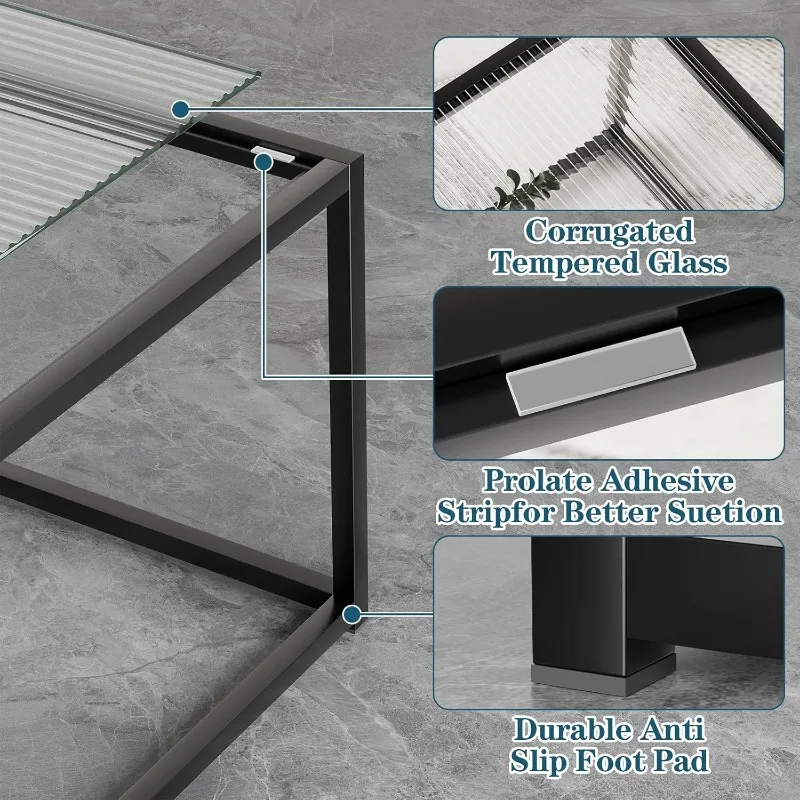
Stone Variations
Marble-top coffee tables and other stone options provide luxurious, substantial presence with natural variation that ensures each piece is unique. Options include:
- Marble: Features distinctive veining patterns with elegant appearance
- Granite: Offers exceptional durability with speckled patterning
- Concrete: Provides industrial character with customizable finishes
- Quartz: Combines natural stone appearance with improved durability
Stone surfaces require periodic sealing to prevent staining and typically add substantial weight to the table. They provide excellent heat resistance but may be vulnerable to acidic substances without proper protection.
Mixed Material Combinations
Many contemporary designs combine multiple materials to capitalize on their respective strengths. Popular combinations include wood frames with glass tops, metal bases supporting stone surfaces, or wood structures with metal accents. These combinations allow for greater design flexibility and often result in pieces that harmonize with diverse interior elements.
Structural Elements: Beyond the Surface
The structural composition of a rectangular coffee table significantly influences both its visual character and functional performance. Understanding these elements helps in selecting a table that complements your space while meeting practical needs.
Leg Styles and Their Impact
The legs of a coffee table serve as both structural support and defining design elements. Different leg styles create distinctive visual impressions:
Tapered legs: Gradually narrowing from top to bottom, these legs exemplify mid-century modern design philosophy with their elegant, refined proportions. The angled silhouette creates visual lightness while maintaining structural integrity.
Block/chunky legs: Substantial, squared-off legs communicate contemporary stability and visual weight. This style creates a bold, grounded presence and often appears in modern farmhouse and industrial designs.
Hairpin legs: Thin metal rods bent into triangular supports create an almost floating appearance for the tabletop. These minimalist legs maximize visual space beneath the table, making them ideal for smaller rooms.
Pedestal bases: Central support columns create dramatic, sculptural statements while eliminating corner obstructions. This style works particularly well in high-traffic areas where minimizing leg obstacles improves flow.
X-bases and cross-leg designs: These traditional configurations provide excellent stability while creating geometric interest beneath the tabletop. The intersecting lines draw visual attention and often reference classical furniture forms.
The key design traits of rectangular coffee tables often center around these structural choices, which determine not only aesthetics but also stability, weight distribution, and spatial impact.
Tabletop Thickness and Edge Profiles
The thickness of a coffee table’s top significantly affects its perceived character:
- Thin tops (under 1 inch/2.5cm): Create lightweight, contemporary appearances suitable for modern and minimalist spaces
- Standard tops (1-2 inches/2.5-5cm): Offer balanced proportions for most design styles
- Substantial tops (over 2 inches/5cm): Provide visual weight and traditional presence
Edge profiles further refine the table’s character:
– Straight edges: Create clean, contemporary lines
– Beveled edges: Soften the table’s appearance with angled transitions
– Rounded/bullnose edges: Introduce gentle, flowing lines ideal for family-friendly spaces
– Waterfall edges: Extend the top material down the sides for seamless visual flow
Base Construction Types
The base structure beneath the tabletop creates distinctive functional and visual characteristics:
- Four-leg open bases provide traditional stability with clear visual space underneath
- Solid/closed bases create substantial presence with potential hidden storage
- Sled bases feature continuous supports that eliminate individual legs
- Floating designs minimize visible supports for contemporary drama
Each structural approach affects not only aesthetics but also practical considerations like leg room, cleaning access, and visual weight within the space.
Functional Features: Enhancing Usability
Beyond aesthetics, rectangular coffee tables can incorporate numerous functional features that enhance their practical value in daily life. These thoughtful additions transform a simple surface into a multifunctional furniture piece.
Storage Solutions
Integrated storage significantly expands a coffee table’s utility without requiring additional furniture pieces:
Drawer designs provide concealed storage for remote controls, gaming controllers, and other small items. Placement options include single large drawers, multiple smaller drawers, or side-accessible compartments.
Open shelving creates accessible display space while maintaining visual lightness. These configurations work particularly well for frequently accessed items like books, magazines, or decorative objects.
Lift-top coffee tables incorporate mechanisms that raise portions of the tabletop to comfortable working heights. This transformation creates impromptu dining surfaces or workstations without requiring additional furniture.
Hidden compartments conceal storage space beneath hinged sections, sliding panels, or removable tops. These clever features maintain clean lines while maximizing functionality.
Nesting table combinations include smaller tables that tuck beneath the main coffee table when not needed. This arrangement provides flexible surface options for entertaining or occasional use.
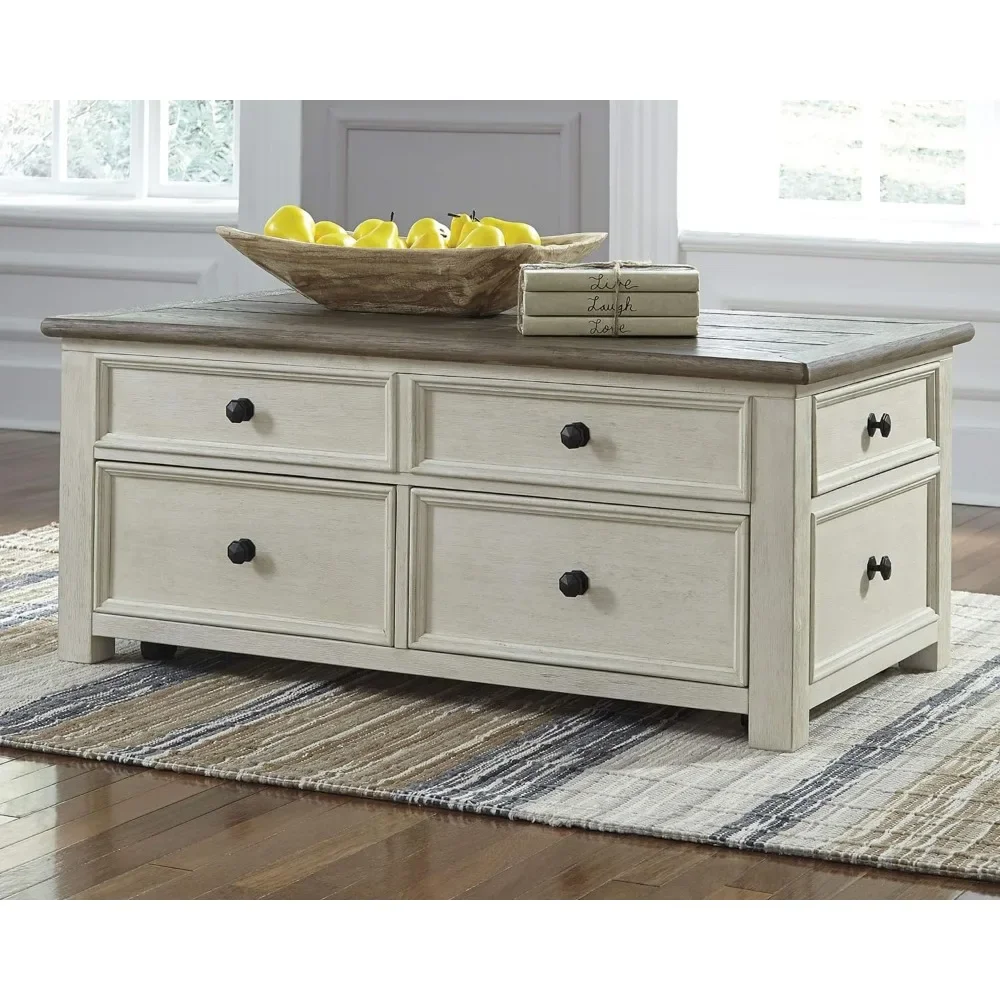
Mobility Features
The ability to reposition a coffee table adds significant versatility to living spaces:
Caster wheels allow easy movement for cleaning or reconfiguring room layouts. Options include lockable casters (for selective mobility), hidden wheels (for subtle functionality), or decorative vintage-style casters (for design integration).
Lightweight construction facilitates repositioning even without wheels—particularly valuable in spaces that serve multiple functions throughout the day.
Handles or grips integrated into the design make movement more ergonomic and convenient, especially for heavier tables.
Height Adjustability
Adaptable height features accommodate diverse activities and user preferences:
Manual adjustment mechanisms typically offer 2-3 preset heights through lifting, turning, or folding components.
Hydraulic/gas lift systems provide smooth, continuous height adjustment with minimal effort.
Convertible designs transform between coffee table height (16-18 inches/40-46cm) and dining height (28-30 inches/71-76cm) to maximize functionality in compact spaces.
Each functional enhancement addresses specific lifestyle needs—families may prioritize sturdy construction and rounded edges, while apartment dwellers might value integrated storage and space-saving features. The key is identifying which functional elements best complement your specific living patterns.
Design Styles: Finding Your Perfect Aesthetic
The design style of a rectangular coffee table significantly influences the overall character of your living space. Each distinct aesthetic approach brings unique characteristics that can either harmonize with or define your interior design direction.
Modern & Contemporary
Modern and contemporary rectangular coffee tables emphasize clean lines, uncluttered forms, and material honesty. Key characteristics include:
- Minimalist silhouettes with limited ornamentation
- Mixed material compositions (metal with glass or wood)
- High-contrast color relationships
- Geometric precision and intentional asymmetry
These designs prioritize visual lightness and functional simplicity, often featuring floating tops or sculptural base elements that create visual interest through form rather than decoration.
Mid-Century Modern
The enduring appeal of mid-century modern coffee tables stems from their perfect balance of function and organic form. Distinctive features include:
- Tapered, angled legs with outward orientation
- Warm wood tones (particularly walnut and teak)
- Organic shapes with softened corners
- Integration of multiple materials within single pieces
- Modest proportions with emphasis on horizontal lines
Styling secrets for rectangular mid-century tables often involve complementing their warm woods with textural elements and sculptural accessories that enhance rather than overwhelm their clean lines.
Industrial
Industrial coffee tables celebrate utilitarian materials and structural honesty with:
- Raw or distressed metal frameworks
- Reclaimed wood surfaces with visible character
- Exposed hardware and mechanical elements
- Substantial proportions with robust construction
- Vintage-inspired casters or adjustable height mechanisms
These tables often reference historical factory furniture through material choices and functional elements while adapting these principles for contemporary living.
Traditional & Classic
Traditional rectangular coffee tables feature refined proportions and historical references:
- Ornate detailing such as carved legs or decorative edge profiles
- Rich, polished wood finishes (mahogany, cherry, oak)
- Symmetrical designs with balanced proportions
- Cabriole legs, ball-and-claw feet, or turned elements
- Formal presence with substantial visual weight
These designs connect to historical furniture traditions while providing timeless elegance that complements traditional interior schemes.
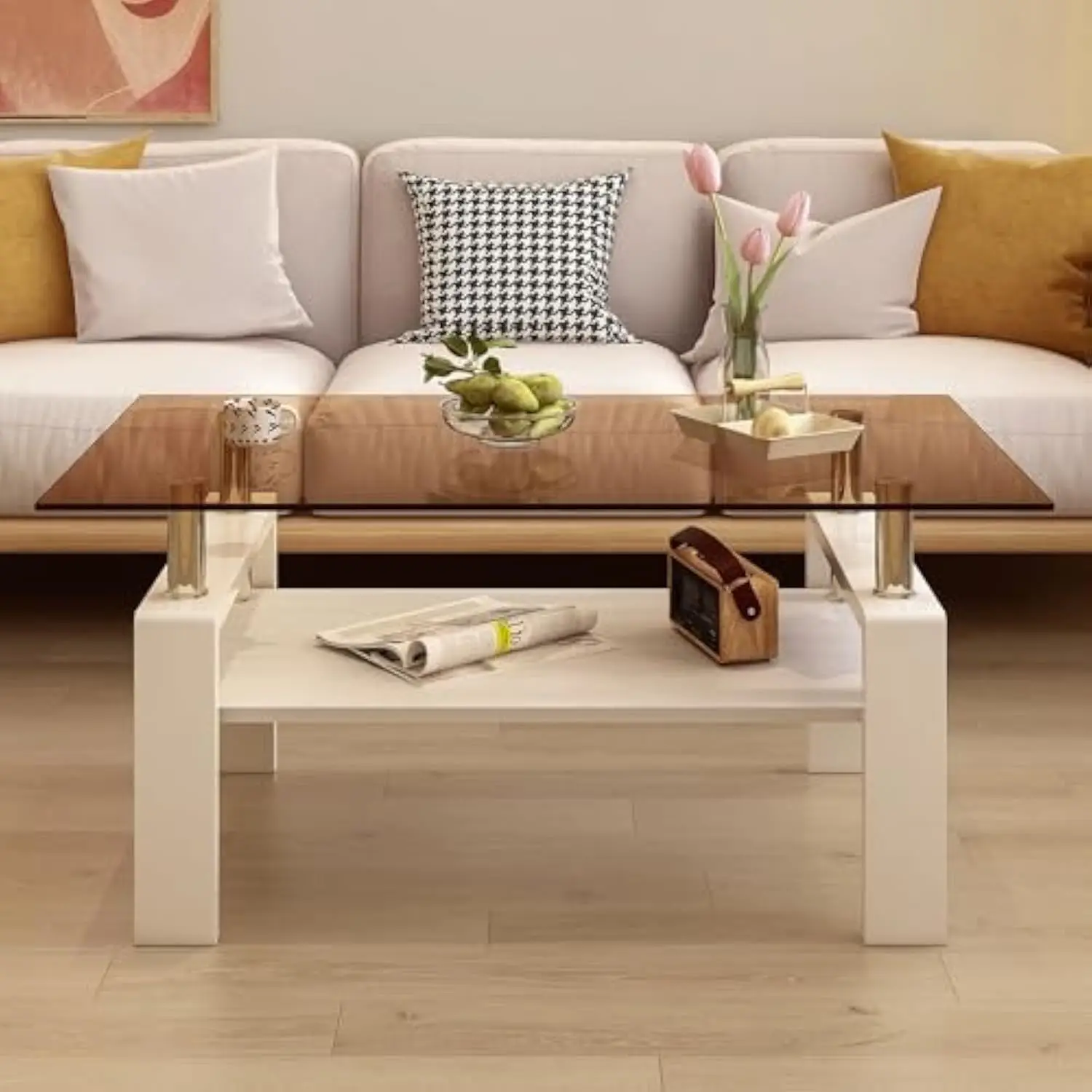
Farmhouse & Rustic
Farmhouse and rustic rectangular coffee tables emphasize natural materials and craft traditions:
- Distressed or weathered wood surfaces
- Simple, sturdy construction techniques
- Visible joinery or metal accents
- Approachable, informal character
- Natural finish options that highlight wood grain
These tables bring warmth and authenticity to contemporary spaces through their emphasis on natural materials and handcrafted qualities.
Minimalist & Scandinavian
Minimalist and Scandinavian approaches prioritize functional simplicity and visual lightness:
- Light wood tones (ash, birch, or bleached oak)
- Streamlined forms without excess detailing
- Rounded edges and gentle transitions
- Integration with natural elements
- Perfect proportions with thoughtful restraint
These designs create calm, harmonious spaces through their uncluttered forms and natural material palette.
Mid-Century Modern Solid Wood Coffee Tables, Mid-Century Modern Teak Coffee Tables
$879.95 Select options This product has multiple variants. The options may be chosen on the product pageMid-Century Modern Danish Coffee Tables, Mid-Century Modern Oval Coffee Tables, Mid-Century Modern Solid Wood Coffee Tables
$390.05 Select options This product has multiple variants. The options may be chosen on the product pageMid-Century Modern Nesting Side & End Tables, Mid-Century Modern Nesting Table Sets, Mid-Century Modern Round Side & End Tables
Price range: $239.35 through $273.06 Select options This product has multiple variants. The options may be chosen on the product pageMid-Century Modern Coffee & End Table Sets, Mid-Century Modern Coffee Table Sets, Mid-Century Modern Oval Coffee Tables
Price range: $257.48 through $331.04 Select options This product has multiple variants. The options may be chosen on the product pageMid-Century Modern Glass Top Coffee Tables, Mid-Century Modern Glass Top Side & End Tables
$460.58 Select options This product has multiple variants. The options may be chosen on the product pageMid-Century Modern Glass Top Coffee Tables, Mid-Century Modern Vintage Coffee Tables, Mid-Century Modern Vintage Side & End Tables
$725.36 Select options This product has multiple variants. The options may be chosen on the product page
At Hearth Forms, we celebrate these diverse design traditions through carefully curated collections that honor authentic design principles while meeting contemporary quality standards.
Proportions and Scale: Achieving Perfect Balance
The dimensional relationships between your rectangular coffee table and surrounding furniture significantly impact both visual harmony and practical functionality. Proper proportions create comfortable, balanced living spaces while improper scaling can disrupt both aesthetics and usability.
Length and Width Guidelines
For rectangular coffee tables, the length-to-width ratio typically falls between 1.5:1 and 2:1, creating pleasing proportions that complement standard seating arrangements. For optimal balance with your sofa:
Length: The ideal coffee table length ranges from 1/2 to 2/3 of your sofa’s length. For a standard 84-inch (213 cm) sofa, this translates to approximately 42-56 inches (107-142 cm).
Width: Table width should allow for comfortable passage around all sides while providing adequate surface area. Typically, 22-30 inches (56-76 cm) works well for most living room configurations.
Clearance: Maintain 16-18 inches (40-46 cm) between the table edge and seating to allow comfortable leg room while keeping items within easy reach.
Transforming your room layout with rectangular coffee tables involves understanding these spatial relationships and how they contribute to both flow and function within the space.
Height Considerations
The height relationship between your coffee table and seating is crucial for both visual harmony and practical functionality:
Standard height: Most rectangular coffee tables measure 16-18 inches (40-46 cm) tall, positioning the surface slightly below standard sofa seat height (typically 17-19 inches or 43-48 cm).
Relative positioning: For optimal comfort, the table surface should be no more than 1-2 inches (2.5-5 cm) lower than sofa seat height. This relationship ensures easy reach without awkward bending.
Visual proportions: Lower tables (under 16 inches/40 cm) create casual, relaxed atmospheres while taller options (18-20 inches/46-51 cm) establish more formal environments.
Room Size Impact
The dimensions of your living space should directly influence coffee table selection:
Small rooms benefit from narrower tables (20-24 inches/51-61 cm wide) with open bases that create visual space. Small coffee tables with glass tops further reduce visual weight.
Large spaces can accommodate large rectangular coffee tables (48-60 inches/122-152 cm long) with more substantial proportions that prevent the piece from feeling insignificant within the room.
Open concept areas may benefit from tables that help define distinct functional zones through their positioning and proportions.
Visual weight—the perceived heaviness or lightness of a piece—also affects spatial balance. Dark finishes, solid bases, and substantial materials create stronger visual presence, while light colors, transparent elements, and delicate frameworks reduce perceived weight.
Durability and Maintenance: Ensuring Longevity
The materials and construction of your rectangular coffee table determine not only its appearance but also its durability and maintenance requirements. Understanding these factors helps ensure your selection provides lasting beauty and functionality.
Material-Specific Durability
Different materials offer varying levels of resilience against common household challenges:
Wood durability: Walnut coffee tables and other hardwoods like oak and maple offer excellent resistance to dents and scratches. Softwoods like pine require more careful treatment. All wood benefits from protective finishes that guard against moisture and staining.
Metal resilience: Steel and iron provide exceptional structural strength but may be susceptible to scratching or corrosion without proper finishing. Aluminum offers lightweight durability with natural corrosion resistance.
Glass considerations: Tempered glass provides significantly improved safety and durability compared to standard glass, breaking into small, less dangerous pieces if damaged. Look for tables with glass thickness of at least 8-10mm (approximately 3/8 inch) for adequate strength.
Stone durability: Marble and other natural stones offer excellent scratch resistance but remain vulnerable to etching from acidic substances. Engineered stone options provide improved stain resistance with similar aesthetic appeal.
Care Instructions by Material
Proper maintenance significantly extends the life and beauty of any coffee table:
Wood Care:
– Dust regularly with soft, dry cloths
– Clean spills immediately to prevent staining
– Use coasters under beverages
– Apply furniture polish or wood conditioner quarterly
– Avoid direct sunlight exposure that can cause fading
Metal Care:
– Wipe with slightly damp cloth to remove fingerprints
– Use specialized metal cleaners for deeper cleaning
– Touch up any chips in painted finishes to prevent rust
– Apply metal polish appropriate to specific finish type
Glass Care:
– Clean with ammonia-free glass cleaner
– Use microfiber cloths to avoid streaking
– Place protective pads under objects to prevent scratches
– Immediately clean fingerprints and smudges for best appearance
Stone Care:
– Apply stone sealer every 6-12 months
– Clean with pH-neutral cleaners only
– Blot rather than wipe spills to prevent spreading
– Use trivets under hot items to prevent thermal shock
Protection Techniques
Preventative measures significantly extend coffee table longevity:
- Use table runners to protect central surfaces
- Apply felt pads to the bottom of decorative objects
- Consider glass toppers for valuable wood surfaces
- Implement consistent maintenance routines
- Position tables away from direct sunlight when possible
With proper care, quality rectangular coffee tables can remain beautiful and functional for decades, making them wise investments for your living space.
Practical Buying Considerations
Beyond design features and materials, several practical factors influence the coffee table selection process. Understanding these considerations helps ensure your choice meets both immediate needs and long-term expectations.
Budget Expectations
Rectangular coffee table pricing varies dramatically based on materials, construction quality, and design complexity:
Entry-level options ($150-300) typically feature engineered wood construction with veneer finishes or basic metal/glass combinations. While affordable, these may offer limited durability for high-use environments.
Mid-range selections ($300-800) introduce solid wood components, higher-quality glass, and more refined construction details. These tables generally offer good value with reasonable longevity.
Premium choices ($800-2,000+) feature exceptional craftsmanship, premium materials like solid hardwoods or natural stone, and distinctive design elements. These investment pieces often appreciate in value over time while providing superior durability.
The best rectangular mid-century coffee tables typically fall within the mid-to-premium range, reflecting their quality construction and timeless design characteristics.
Assembly Requirements
Different purchase options present varying assembly challenges:
Ready-assembled tables eliminate setup hassles but may present delivery challenges due to their size. These are ideal for those seeking immediate use without assembly frustration.
Flat-pack designs require home assembly but arrive in compact packages that facilitate easier delivery and movement into the home. Assembly complexity varies significantly between manufacturers.
Partial assembly options arrive with major components pre-assembled, requiring only simple final steps like attaching legs.
When purchasing online, carefully review assembly requirements, necessary tools, and estimated completion time to avoid unexpected complications.
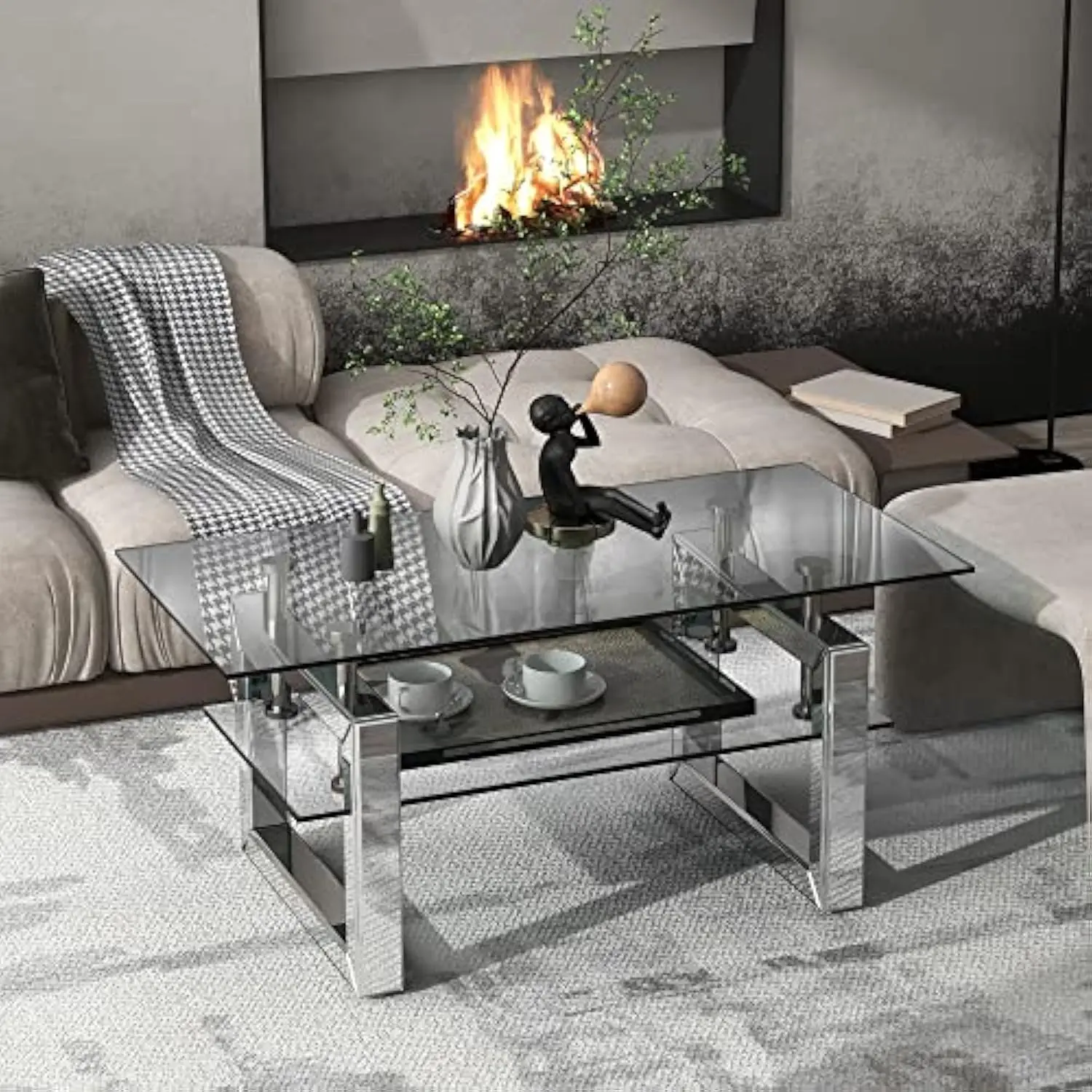
Evaluating Quality Online
When shopping for tables online, several indicators help assess quality without physical examination:
- Detailed material specifications (specific wood types, glass thickness)
- Construction method descriptions (joinery techniques, structural reinforcements)
- Close-up images of details and finish quality
- Weight specifications (heavier pieces generally indicate more substantial materials)
- Customer reviews focusing specifically on construction quality
Additionally, understanding return policies becomes particularly important when purchasing furniture online without physical inspection.
Pre-Purchase Measurements
Before finalizing any coffee table purchase, accurate measurements prevent costly mistakes:
- Measure your available floor space, accounting for comfortable passage around all sides
- Confirm ceiling height clearance if considering lift-top mechanisms
- Measure doorways, hallways, and stairwells to ensure delivery access
- Note the height of existing seating for proper proportion planning
- Consider the scale of other furniture pieces to maintain balanced proportions
These practical considerations ensure your selected table not only looks beautiful but also functions effectively within your specific living environment.
Styling Your Rectangular Coffee Table
The way you style your coffee table transforms it from a simple functional piece into a design statement that reflects your personality and enhances your living space. Strategic styling creates visual interest while maintaining practical usability.
Professional Styling Techniques
Design experts employ several principles to create visually appealing coffee table arrangements:
The rule of three suggests grouping objects in odd numbers (typically three) to create dynamic, asymmetrical interest that engages the eye. For example, combining a stack of books, a decorative box, and a small plant creates visual harmony through diversity.
Height variation establishes visual dimension by combining tall, medium, and short elements. This layered approach creates depth and prevents the arrangement from appearing flat or monotonous.
Textural contrast introduces tactile interest through the juxtaposition of different surface qualities—smooth ceramics against rough natural elements, or soft fabric items paired with polished metals.
Color coordination ties arrangements to your broader color scheme through intentional selection. Limited color palettes (2-3 complementary tones) create sophisticated, cohesive displays.
How to decorate rectangular coffee table tops often involves dividing the surface into distinct zones—perhaps a decorative area, a practical space for remote controls, and an empty section for drinks or personal items.
Functional Décor Recommendations
Styling should enhance rather than impede your table’s practical function:
Decorative trays contain smaller items while creating visual organization. They also facilitate easy removal when more surface area is needed.
Stacked books or magazines provide both personal interest and height platforms for smaller objects. Choose titles that reflect your interests while complementing your color scheme.
Lidded boxes offer concealed storage for remote controls and other small necessities while contributing to the overall design composition.
Natural elements like small plants or stone objects introduce organic forms that soften geometric furniture lines.
Seasonal Variations
Refreshing your coffee table styling seasonally maintains visual interest over time:
- Spring arrangements might feature lighter colors and botanical elements
- Summer styling could incorporate coastal elements or vibrant accents
- Fall displays often include warmer tones and textural elements
- Winter arrangements typically feature cozy elements and subtle holiday references
These seasonal refreshes maintain visual interest while allowing your core furniture pieces to remain constant.
How to Choose the Right Rectangular Coffee Table for Your Lifestyle
Selecting the perfect rectangular coffee table ultimately depends on how your specific lifestyle influences both practical needs and aesthetic preferences. Understanding your unique requirements helps prioritize features that will provide the greatest value in daily use.
Family-Friendly Considerations
Households with young children benefit from tables designed with safety and durability in mind:
- Rounded corners and edges minimize injury risks from accidental collisions
- Sturdy construction withstands climbing attempts and rough play
- Stain-resistant materials like certain woods with protective finishes or tempered glass simplify cleanup
- Storage features keep toys and potential hazards contained
- Soft-close drawers prevent pinched fingers
Pet Owner Priorities
Homes with pets benefit from specific design features:
- Scratch-resistant surfaces resist damage from claws
- Sturdy construction prevents tipping if pets jump onto the table
- Easy-clean materials simplify fur and accident management
- Lower-shelf designs provide pet lounging spaces (an added bonus!)
Small Space Solutions
Apartment dwellers and those with limited square footage should prioritize:
- Narrower widths (20-24 inches/51-61 cm) that maintain function without dominating floor space
- Multi-functional designs with storage components to reduce additional furniture needs
- Small coffee tables with lighter visual weight through glass tops or open bases
- Nesting tables that expand when needed and contract when space is premium
Entertainer Essentials
Frequent hosts benefit from features that enhance social gatherings:
- Larger surface areas accommodate multiple drinks and appetizers
- Durable materials withstand increased use and occasional accidents
- Easy-clean surfaces simplify post-gathering maintenance
- Potentially expandable designs for larger events
The complete guide to rectangular coffee table design provides additional insights into matching specific table features with lifestyle requirements, helping you prioritize the elements that will provide the most value in your particular circumstances.
Rectangular vs. Other Coffee Table Shapes: When to Choose Each
While rectangular coffee tables offer numerous advantages, other shapes may better suit specific spaces or design objectives. Understanding the comparative strengths of different geometric forms helps determine the ideal choice for your particular setting.
Rectangular vs. Round Tables
The primary differences between rectangular and round coffee tables involve both practical function and visual impact:
Rectangular Advantages:
– Provide maximum usable surface area
– Complement standard sofa arrangements
– Create clear traffic patterns with defined edges
– Establish structured, organized visual presence
Round Advantages:
– Eliminate sharp corners (child-friendly)
– Facilitate conversation with equal-distance seating
– Navigate more easily around in tight spaces
– Soften rooms dominated by straight lines
The question of whether to have a round or rectangle coffee table often depends on your seating arrangement. L-shaped sectionals typically work better with rectangular tables that parallel the sofa lines, while floating furniture arrangements (where seating surrounds all sides) often benefit from round tables that facilitate equal access.

Rectangular vs. Square Tables
The choice between rectangular and square coffee tables often relates to room proportions and seating configuration:
Rectangular Benefits:
– Provide directional guidance in elongated rooms
– Offer greater surface area without excessive width
– Create natural alignment with standard sofas
Square Benefits:
– Create perfect symmetry in balanced room layouts
– Work well with equal seating on all sides
– Provide proportional presence in square rooms
Square tables generally work best in perfectly balanced seating arrangements where equal access from all sides is desired, while rectangular options better serve traditional sofa-centered layouts.
Combining Different Shapes
Many contemporary designers embrace mixed-geometry approaches:
- Rectangular coffee tables paired with round side tables create dynamic visual interest through shape contrast
- Nesting tables that combine different geometric forms offer versatility
- Asymmetrical or organic shapes can complement rectangular pieces through intentional contrast
The round vs. rectangle coffee table comparison ultimately depends on your specific space, seating arrangement, and design objectives. Neither option is universally superior—each offers distinct advantages for particular situations.
Are Rectangular Coffee Tables Going Out of Style?
Despite evolving interior design trends, rectangular coffee tables maintain their position as versatile classics rather than temporary fashion statements. Their enduring appeal stems from their practical functionality and adaptable forms that transcend specific style movements.
While design trends naturally cycle, rectangular coffee tables have demonstrated remarkable staying power across decades. The fundamental form remains consistent, but expressions evolve through material choices, proportions, and detailing that reflect contemporary sensibilities.
Current design trends actually reinforce the rectangular table’s relevance through several developments:
- Multi-functional designs that incorporate functional lift-top mechanisms address modern needs for flexible living spaces
- Mixed-material compositions that combine traditional woods with contemporary metals create transitional pieces that bridge style categories
- Sustainable material options like reclaimed wood bring environmental consciousness to traditional forms
- Softened corners and organic edge profiles maintain rectangular functionality while introducing subtle contemporary influences
Rather than becoming dated, rectangular coffee tables continue evolving while maintaining their fundamental appeal. What changes over time are the specific expressions—finishes, materials, proportional relationships—rather than the basic form itself.
This adaptability explains why rectangular tables remain the dominant choice in both residential and commercial settings. Their ability to serve diverse functional needs while accommodating changing aesthetic preferences ensures their continued relevance in contemporary interiors.
Can You Mix Rectangular Tables with Round Side Tables?
Combining rectangular coffee tables with round side tables creates dynamic visual interest through intentional geometric contrast. This mixed-shape approach has become increasingly popular in contemporary interior design for several compelling reasons.
The pairing works successfully when unified through common elements that create visual cohesion despite different shapes:
- Consistent material palette (same wood species or metal finish)
- Complementary color tones across different pieces
- Similar design language or period reference
- Proportional relationships (height alignment between pieces)
- Shared detailing (edge profiles, leg styles, hardware)
The contrast between linear and circular forms creates visual tension that engages the eye while providing functional variety. Rectangular coffee tables provide structured, directional surfaces for central activities while round side tables offer approachable, accessible surfaces for individual seating positions.
For successful mixed-shape combinations:
- Maintain consistent height relationships between pieces
- Ensure adequate spacing between different shapes
- Use round forms to soften traffic flow around rectangular pieces
- Consider nesting tables that incorporate both geometries
- Reinforce connections through styling elements that bridge different pieces
This approach reflects contemporary design’s movement away from rigidly matched furniture “sets” toward more collected, intentionally curated combinations that create visual interest while maintaining cohesive design integrity.
What Height Should a Rectangular Coffee Table Be Compared to the Sofa?
The height relationship between your rectangular coffee table and sofa fundamentally impacts both visual harmony and practical functionality. While design rules provide helpful guidelines, understanding the principles behind these measurements allows for thoughtful customization.
The ideal coffee table height typically falls 1-2 inches (2.5-5 cm) below your sofa’s seat height. For standard sofas with seat heights of 17-19 inches (43-48 cm), this translates to coffee tables measuring 16-18 inches (40-46 cm) tall.
This slight height differential accomplishes several important objectives:
- Functional convenience: Items remain within comfortable reach without awkward stretching or bending
- Visual hierarchy: The lower table height prevents competition with seating elements
- Proper proportion: The relationship creates visual harmony rather than awkward misalignment
- Comfortable leg positioning: Allows comfortable leg extension under or beside the table
To measure correctly:
– Measure from the floor to the top of your sofa cushion (when compressed as if someone were sitting)
– Subtract 1-2 inches (2.5-5 cm) from this measurement for ideal coffee table height
– Consider leg clearance if the table has a shelf or lower structural elements
Round vs. rectangle coffee tables follow similar height principles, though rectangular tables typically offer more consistent height across their entire surface compared to some round pedestal designs with variable edge heights.
Exceptions to standard height guidelines might include:
– Higher tables (19-21 inches/48-53 cm) for taller sofas or formal settings
– Lower tables (14-16 inches/35-40 cm) for deep, low-profile seating or casual environments
– Adjustable-height mechanisms for versatile functionality
This height relationship remains consistent regardless of table shape, though the proportional balance becomes particularly important with rectangular tables that parallel sofa lines.
Frequently Asked Questions
What materials are best for homes with children and pets?
For households with children and pets, prioritize durable, forgiving materials that withstand daily challenges. Solid hardwoods with protective finishes resist scratches and dents while remaining repairable if damaged. Metal frames with tempered glass provide stability and easy cleaning, though ensure glass edges are properly beveled for safety. Avoid highly polished surfaces that show fingerprints and marble tops that can etch from spills. Look for rounded corners and edges to prevent injuries during active play.
What size rectangular coffee table works best for small living rooms?
Small living rooms benefit from proportionally scaled rectangular coffee tables, typically 36-42 inches (91-107 cm) long and 20-24 inches (51-61 cm) wide. These dimensions provide functional surface area without overwhelming limited floor space. Consider tables with open bases or glass tops to maintain visual spaciousness, and look for integrated storage to reduce clutter. Maintain at least 16 inches (40 cm) of clearance between the table and surrounding furniture to ensure comfortable passage.
How should I position a rectangular coffee table with a sectional sofa?
With L-shaped sectionals, position rectangular coffee tables parallel to the longest sofa section, maintaining equal distance from both segments when possible. Allow 16-18 inches (40-46 cm) between the table and sofa edge for comfortable access. For larger sectionals, consider using multiple smaller tables or nesting table sets that provide flexible arrangement options. The table should cover approximately 1/2 to 2/3 of the seating area length for proper visual balance.
How durable are lift-top mechanisms in coffee tables?
Quality lift-top mechanisms typically maintain functionality for 7-10 years with regular use. Look for tables with metal rather than plastic components in the lifting hardware, counterbalanced springs that prevent slamming, and smooth-operating hydraulic systems. Higher-end mechanisms include locking positions and gradual descent features. The overall durability depends significantly on construction quality, with premium tables offering replaceable mechanism parts that extend functional lifespan.
What is the ideal distance between a rectangular coffee table and sofa?
The ideal clearance between a rectangular coffee table and sofa ranges from 16-18 inches (40-46 cm). This distance provides comfortable leg room while keeping items within easy reach. For high-traffic areas, increase this spacing to 18-20 inches (46-51 cm) to improve flow. The clearance should never fall below 14 inches (35 cm), as this creates awkward movement and difficult access. For rooms with multiple seating pieces, maintain consistent spacing on all sides to create balanced, intentional arrangements.
Understanding these considerations helps create coffee table arrangements that enhance both the functionality and aesthetics of your living space while addressing the practical realities of daily use. The principles of solid wood coffee table materials provide additional guidance on selecting durable, appropriate options for your specific circumstances.

